#popular historical iconography
Text



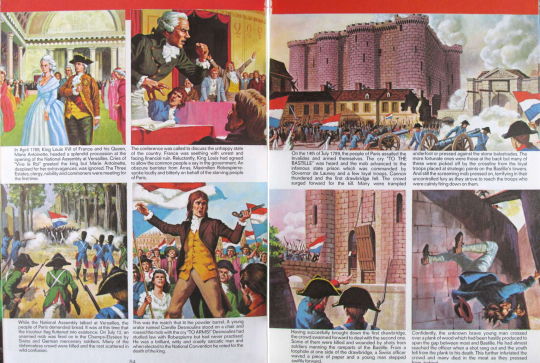
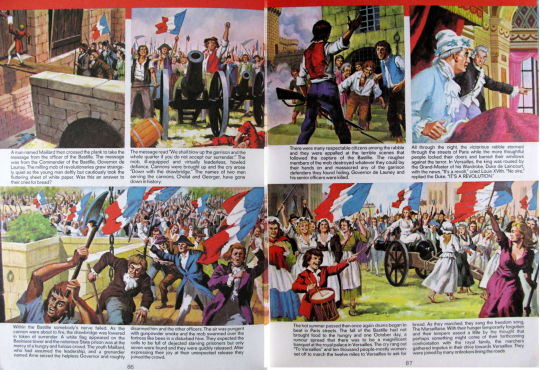
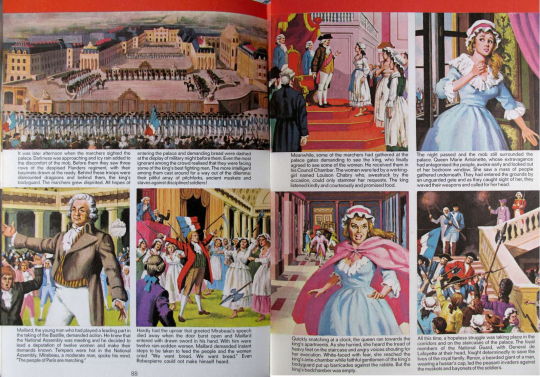
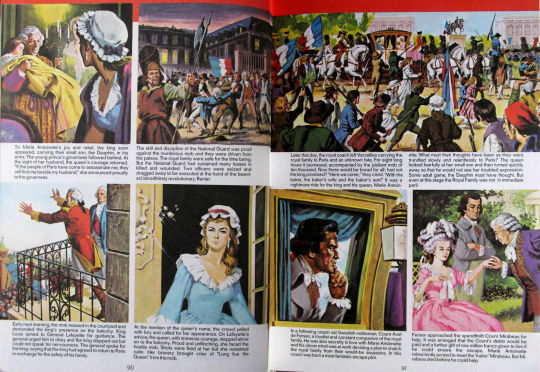
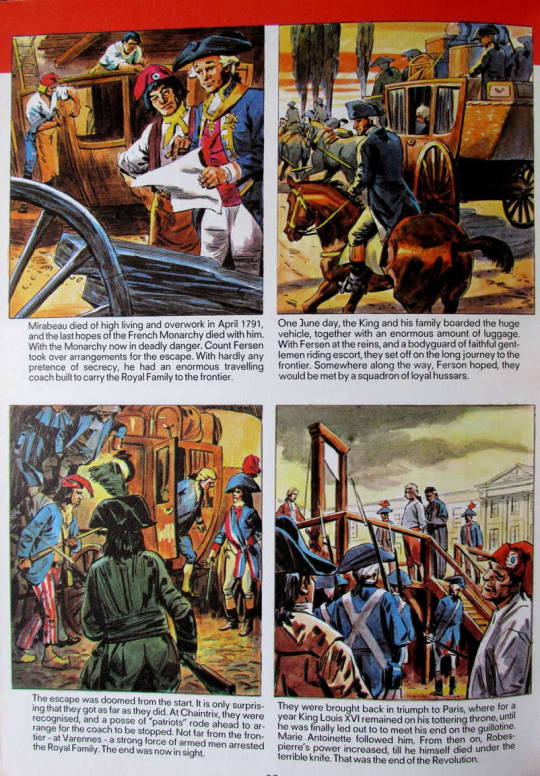
Tell Me Why children's annual 1970
@suburbanbeatnik @trashpoppaea @montagnarde1793 @patientsisavertu @taleon-arts @vivelareine
If you thought Jackie 1976 was bad… This is from Tell Me Why, a non-fiction annual from 1970. Good to see a piece on Vidocq, but Marie-Antoinette has the Julie Christie/Jean Shrimpton/Catherine Deneuve look of the Jackie heroine, and I'm not sure how old the artist thought Max was…! They've made him look older than Marat! In the children's books of this era, the Brissotins were generally presented as the only Revolutionaries you were allowed to like.
#french revolution#révolution française#popular historical iconography#popular historiography#vintage children's books
54 notes
·
View notes
Text
Steph the Alter Nerd is reading Omid’s new book.
Following the live read:
I joined late so Steph was already reading. She was starting the Sophie section. Seriously, why pick on Sophie who just puts her head down and focuses on work? That’s strikes me as unnecessarily vile.
Omid apparently thinks Charles hasn’t modernized the monarchy. Dude is an environmental icon and we now have a blended family in BP. That may not be everyone’s cup of tea, but you can’t deny that it’s modern.
Apparently Omid writes pages and pages about Charles’ “leaky pen” incident. It’s just a pen, Omid. Omid thinks this means Charles may not be up to the job, lololol. I’m dying. Mind you, Omid worships Harry who stripped in Vegas, wore a Nazi uniform, and called his fellow soldiers names. But yes, the leaky pen is far more significant than all that, somehow.
Really boring part about government stuff. Charles negotiates and reaches compromises with the government and that’s apparently bad? Also, Charles didn’t know what to expect after he became King??? Lolololol.
Charles lost sympathy for the Harkles after the documentary. Well, duh. We all did, Omid. That documentary was a huge own goal.
He blames the Royal Family for the documentary’s melodrama? Seriously? Who was crying on Oprah? Who was crying in a rented Vancouver mansion with her head wrapped in a towel? Who dropped hot, salty tears on her Hermes blanket? That’s the person responsible for the melodrama.
Anne supposedly kicked them out of Frogmore. I suspect this is fanfiction, but I love it. I want it to be true. This is my headcanon now.
And I do thin fanfiction is the right term for this book. The BRF is super popular right now so the book thesis itself (that the BRF is in trouble) is pretty fantastical.
This book seems very, very boring. Omid seems to be desperately trying to argue that Charles’ first year went badly, but that’s just not reality. Omid used to be better at spinning than this.
Make the Royals Great Again? Uh, that was done in 2011. Everything we are seeing now was planted way back then, down to Kate’s leafy crown. There’s a general lack of both self-awareness and historical awareness in this book. Omid writes like someone who first became a “royal reporter” in 2016…which is exactly what he is. Too bad, because I do think there’s an interesting analysis that could be made regarding 2023 and it’s place in royal pr. That’s above Omid’s pay grade though.
Lol, Omid discusses UK politics and it’s every bit as much of a disaster as one would expect. Stick to gossip, Omid.
Ok, Steph’s hydrating, so let’s step back for a minute and recall what this book was supposed to be. This was to be “Finding Freedom 2.0,” a chronicle of the Harkle post-Megxit success story. The publishers clearly didn’t like that and they made Omid write a book about the family as a whole. That’s because there was no Harkle success story and the publisher didn’t think another Harkle book would sell. Unfortunately, Omid is a Harkle specialist. He can’t write a book about the family (let alone successfully argue for its imminent demise). He simply doesn’t know enough.
Back to Steph. We’re now in Harry’s military service? Er, why? We jumped from 2023 to 2016 and now to the Afghanistan War?
I agree with Steph that Omid’s trying to associate the royals with MAGA and I can’t even articulate how stupid that is. Completely different countries, completely different cultures, completely different iconography. Just doesn’t work.
Now we’re at the Coronation Concert? The royals are in trouble because Elton wasn’t at the concert! Lolololol. The Harkle bubble is out of this world. Basically, if their inner circle wasn’t centered (Oprah, Elton, Omid, etc…), it’s because of a MAGA conspiracy that will bring the royals down.
Something, something throne. Charles looked awkward again. Constitutional crisis!
I feel like I’m grading student briefs. There’s a way to argue this and there is evidence you can cite for this argument, but this isn’t it. You shouldn’t write pages and pages about a leaky pen and then minimize the bags of charity money as “perception.” You should start with the bags of charity money then use the leaky pen to bolster the “perception” argument.
Another disagreement with the government. Aargh! That should be lumped together with the other arguments with the government. Or it shouldn’t be mentioned at all. You’re arguing that Charles is and old-fashioned idiot who is not a good king, so why make him look like someone who is aware of current social issues and engaged with his government?
Racism. Finally! No wait, it’s boring.
Charles had an affair with Camilla. Lol, that’s not exactly news, love. The time jumping is driving me nuts.
Took a break to let the dog out and now we’re in Andrew’s interview. Of course we are.
Will exiled Andrew. I hope this is true. Wait, that’s the famous “power struggle”? Andrew??? I don’t think that’s a power struggle. That’s just Charles passing the buck.
Oh, lord. More Andrew. That’s it. I’m going to bed. I’ll tune back tomorrow.
122 notes
·
View notes
Note
Since we're on a Viking bent at the moment, how did they come to be badasses within popular culture?
This is an excellent question!
I think Western pop culture has a weakness for historical warrior cultures in general - there was a big fad for samurai starting in the 70s thanks to Kurosawa films becoming crossover hits, there was a big moment for Spartans after Zack Snyder's film in 2006, there was another one for Romans between the HBO show in 2005 and the Starz Spartacus shows in the early 2010s - for complicated cultural reasons that keep historians like Bret Devereaux busy.

Vikingers had been around as a thing in pop culture off and on for decades - there was The Vikings in 1958 with Kirk Douglas and or the 13th Warrior with Antonio Banderas in 1999 - but it tended to be hit-or-miss one-offs rather than a general pop cultural trend until relatively recently. Sustained interest in Vikingers really does kind of trace back to the huge success of the History Channel show which ran from 2013-2020 - which is funny, because originally it was a pretty naked attempt to find something that would tap into the Game of Thrones audience, for all that Hirst hates the comparison- which prompted others to tap into the same audience with Assassin's Creed: Valhalla and The Last Kingdom and God of War, and so on. It's rare that one show hits big enough to cause a trend, but I do think you have to hand it to them in this case.
So why did Vikingers hit so big?
Part of it is that they come pre-packaged with visual iconography (the dragon-ships, the distinctive helmets and shields and axes, the rather inaccurate hairstyles, etc.) and mythology (Norse mythology has the virtue of being decently well-known enough that people recognize who the gods are, but not well-known enough that people complain if you make shit up that wasn't in the Eddas), so a lot of the "branding" has already been done for the creators.

I think another big part of it is that Vikingers kind of act as a cultural Rorschach test that allows people to see what they want - you can go all the way along the spectrum from right-wing Neo-Nazis seeing them as Aryan supermen destroying Western decadence through the will to power to left-wingers thinking that the Vikingers were progressive because they were relatively gender-egalitarian and didn't like Christians very much.
And finally, I think that Vikingers have the benefit of being far enough back in history and niche enough a historical subject that it disarms a lot of people's critical faculties. Here's what I mean -thanks to decades of historical research and activism, more recent and prominent examples of slavery and/or colonialism no longer make for protagonist fodder in pop culture. There's a reason why Benioff and Weiss' "Confederates Win" tv show got canned before it started, and there's a reason why something like Zulu could not get made today (and that's a good thing). But just like the Spartans after 300, the Vikingers are seen as "ancient history" and because their oppression was visited on white people rather than POC, you can show them raiding Lindisfarne and colonizing a third of England (although you'll notice showrunners generally leave out the trans-continental slave trade) without anyone asking if this is problematic.
48 notes
·
View notes
Text


The Fettercairn Jewel
From my visit to The National Museum yesterday,, this fascinating wee pendant is shrouded in mystery, this is what the museum says about it.
The Fettercairn Jewel is an exceptionally rare Renaissance gold pendant locket. Set with a large almandine garnet, it features an elaborate scene in enamel on the back. The jewel is oval, with a fastening at the top to hold a gold ring, and, at the bottom, a smaller ring, that was originally a catch to hold the case shut. The case opens and would probably have contained a miniature portrait on vellum or ivory or some other personal memento. It would have been worn as a pendant on a chain or pinned to clothing, and it probably had a pearl or precious stone hanging beneath it.
The front of the Fettercairn Jewel, set with a large garnet, but I prefer the back, whichl is decorated with detailed enameled imagery.
The Fettercairn Jewel is one of a very small number of Renaissance jewels to have survived in the British Isles. Jewellery from such an early date has a very low survival rate, due to the historic recycling of precious stones and materials. This makes the survival of the Fettercairn Jewel remarkable.
Its Scottish provenance, and its potential relationship with other known jewels made for Scottish patrons, raise the possibility that the Fettercairn Jewel was made in Scotland or for a 16th-century Scottish patron. Our initial historical research is concentrating on these lines of enquiry.
The Fettercairn Jewel holds the potential to expand significantly our knowledge of the Scottish Renaissance, about the way in which a visually literate society communicated complex messages through objects, and to learn more about the quality and ambitions of 16th-century craftsmanship.
The garnet, on the front was reputed to have medicinal and healing properties.
On the reverse of the pendant the scene centres on a figure of Mercury, with his caduceus, or staff, resting on his outstretched right arm. He is wearing a winged helmet and classical armour, and holding something in his raised left hand.
To the right of Mercury sits a white dog looking upwards, possibly a symbol of fidelity. A vase of flowers stands to his left and more flowers appear elsewhere on the ground. The carefully delineated flowers, including cornflowers, wild roses, violets and marguerites, are all identifiable and many had specific symbolic meanings.
On the horizon are two groups of buildings and a large tree. On the buildings to the left sits a green bird resembling a parrot with its distinctive hooked beak, and on the right a smaller white bird. Above Mercury’s head flies another bird and two butterflies.
The dog, birds and flowers are not part of the usual iconography associated with Mercury, which suggests that the imagery has been designed with a particular meaning and patron in mind. Jewels of this sort often contained complex messages; could the animals and flowers have a heraldic association with the original owner of the Jewel? Is some more complex story hidden in its imagery? So far the Fettercairn Jewel retains its mystery.
Mercury was one of the most popular gods in Renaissance imagery. He was specifically associated at this time as the god of messengers and became closely associated with the officers of arms (the royal heralds) in 16th-century Scotland. An image from the Seton Armorial of c.1591 casts Lyon King of Arms, the king’s personal representative, as Mercury. This could suggest that the Fettercairn Jewel was crafted around the same time, and may indicate a connection to the Scottish court.
We are also trying to establish why the Fettercairn Jewel was made. One possibility links it to the extensive practice of royal court and noble household gift-giving: during the Scottish Renaissance, the royal family gave generous gifts of jewellery to courtiers and ambassadors, a practice common in other European courts of the period.
Alternatively, the Jewel may have been conceived as a token for a beloved family member or spouse. Jewels containing miniature portraits were often exchanged as keepsakes between loved ones, and would often be worn close to the heart.
The pendant came into the National Museums Scotland collection through an auction of over 400 works of art and artefacts from the private collection of the Forbes family, whose home was Fettercairn House in Aberdeenshire. The Forbes of Pitsligo descend from Sir William Forbes, brother of Alexander Forbes, first Lord Forbes. Both branches were prominent elite families in the sixteenth century. The first Lord Forbes married the granddaughter of King Robert II of Scotland and daughter of Douglas, Earl of Angus.
National Museums Scotland is investigating potential links between the Jewel and the Scottish royal court, and the possibility of its links to the Darnley Jewel, now in the Royal Collection. The Darnley Jewel was probably commissioned during the 1570s by Lady Margaret Douglas, Countess of Lennox, as a memorial for her husband Matthew Stewart, earl of Lennox and Regent of Scotland, and was later owned by both Horace Walpole and Queen Victoria. The Fettercairn Jewel shows similarities of design and technique with the Darnley Jewel, and their shared Scottish provenance merits further investigation.
The Fettercairn Jewel is currently on display in the Kingdom of the Scots gallery, near to the Penicuik Jewels, which are associated with Mary, Queen of Scots.
#scotland#scottish#jewellery#pendant#mystery#my pics#history#National Museum of Scotland#Chamber Street#edinburgh
54 notes
·
View notes
Text
Disney (Almost) Made an Anniversary Kamen Rider
You remember during the 2000s where Disney owned Power Rangers? It wasn't a bad era in terms of what was put out, but maybe I'm bias because I grew up with it. Running from Ninja Storm to RPM, Disney had a troubling run with the show - the quality was good for a kid's show, but Disney did not like making it. It's not a secret that they were trying to bury Power Rangers, the show only continuing after RPM because it was bought back by Saban. It doesn't feel like a coincidence they sold back Power Rangers less than a year after buying Marvel Entertainment.

And ever since, Disney has had no interest in Tokusatsu as a genre. You could argue the closest they ever came was Mech-X4, a Disney XD show about a kid controlling a giant robot to save his town.
Then rolls around the 100th anniversary. Tokusatsu is still as popular as ever in Japan and, while Super Sentai isn't as popular as it used to be, Kamen Rider has been going strong ever since it's revival in the Heisei Era.
If Disney wanna make money in Tokusatsu, it makes sense to put it in Kamen Rider.

This is the Imagination Belt. It was released last month and, honestly, I'm glad I got back into Kamen Rider in time to see the strangest anniversary celebration yet. It was produced by Bandai and I won't pretend this is officially a Kamen Rider product - it's made by the same company, but that's not enough to call it that.
But it sure takes a lot of the beats!
As a person who has previously rambled about a non-existent canon surrounding a Sonic Screwdriver toy, I really appreciate that this gives me more to talk about inherently. Kamen Rider historically has been getting more and more Riders with every era of the show and this toy is no different - ten different Disney icons made into marketable... keys... how did they not do Sora-
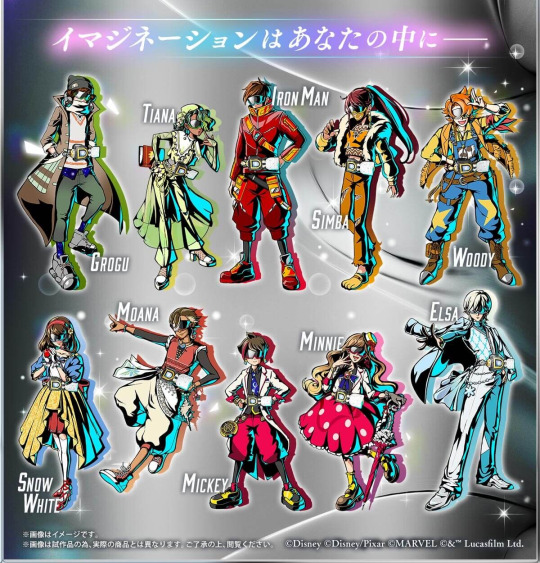
Nevermind, I'm glad they didn't.
The designs aren't great, I won't pretend they are, if you're a fan of Kamen Rider. It's clear the character designs were leaning closer to Kingdom Hearts (or even Spectrobes, if you remember that), so it's hard to judge them in terms of your typical Tokusatsu outfit. That being said, the consistency of the goggles does imply something about this uniform - if it's as important as the belt to be included on everyone, that's notable.
There's also a notable detail with the Imagination Belt itself - the Keys. Half of them are Gold, half of them are Silver, inherently splitting the team of Riders (Imaginators? Imagineers? Disney Adults?) in half. It implies simply that the goals of all the Riders don't align, that perhaps they're in a battle.
The Character Selection is also brought to mind. I imagine it's based on multiple factors, like popularity in that area and inclusion of specific brands... but that doesn't stop them being weird. Including specific representatives for Marvel, Lucasfilms and Pixar absolutely make sense - the choice of Woody is textbook. Iron Man equally makes sense, but the design has him look (personally) more like Lightning McQueen, which may just be a flaw of similar colour schemes.
But Grogu? Ya coulda picked anyone from Star Wars and... I get that The Mandalorian is probably the best received in pop culture... but the implications that he's getting his powers from a space baby is quite funny.
NOTE: The specific split of teams is Gold Keys belong to Mickey, Minnie, Simba, Woody and Iron Man - Silver Keys belong to Snow White, Moana, Tiana, Elsa and Grogu.
youtube
They also have built in power-up modes, specifically "Full Max" which seems to grant a power boost based on related characters - Mickey's Full Max gets help from Donald, Goofy and Pluto, meanwhile Simba has Timon and Pumbaa for example. But in your typical Tokusatsu, if your power-up involves other iconography, that tends to involve beating monsters. Are the monsters for "Imagination Belt" other Disney characters? Were Donald and Goofy evil beasts that had to be defeated? Did Woody have to beat Buzz Lightyear and the other Toys-Turned-Monsters? Minnie's Full Max is her with a cat, did Minnie Mouse have to fight a CAT?!
But onto the Lore Implications...
There's easily enough here to build an insane fanfiction, as you're about to see, but this does continue a point that I really appreciate about toys - kids, collectibles, whatever you want. You can tell your own story and it's not even difficult. Everyone has inherent creativity and, given a small amount of time, you can make any story out of any objects.
Case in point...
"Imagination Belt", to me, feels like Ryuki or Geats - it is a Rider War (Disney Adult War) where these two factions of "heroes" are fighting. It's probably against each other, Gold vs Silver, but you can imagine there are other monsters in between as your usual plot hooks.
The "Riders" of this world likely have their powers from raw imagination - passion for something that manifests in the Keys, giving them power in return. If the imagination becomes twisted.
Based on appearances, the Iron Man and Grogu Riders probably are leading both teams, the conflict started by the both of them and spiraling from there. Mickey is the obvious protagonist, Grogu looks like he'd make a good rival to keep the protagonist moving forward.
And there may be only ten official keys but Disney is an all-consuming black hole of creativity. There could be a lot more and you know it.
17 notes
·
View notes
Text
Deity Guide - Hekate
One phrase to describe this Goddess? It’s complicated!
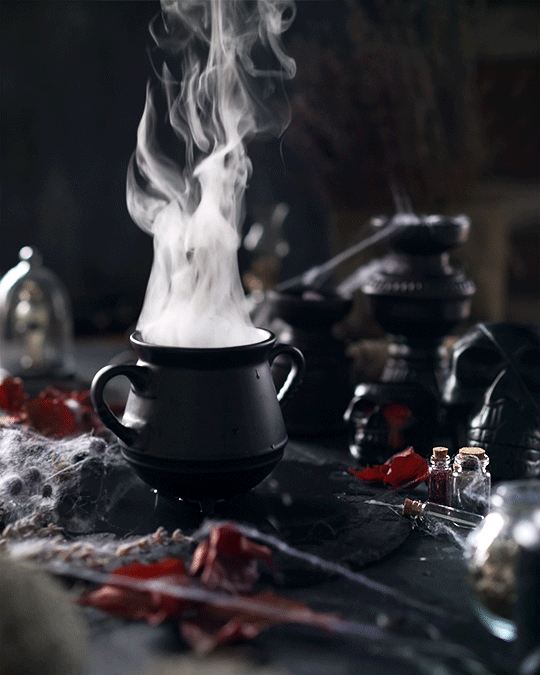
Who is Hekate?
Often called the Goddess of Witchcraft, Hekate (or Hecate) is a Greek goddess who reigns over many domains. She is associated with magic, witchcraft, the moon, necromancy, and spirits. She is also known to be the goddess of boundaries, crossroads, doorways, and, due to being a Goddess of these liminal spaces, became a Goddess of the darkness of the underworld.
Hekate was also worshipped as a hearth goddess, and was thought to protect the home.
The other two deities in the tripartite with Hekate are Persephone and Demeter according to some; to others, the other two are Artemis and Selene or Diana and Luna. In other forms it is simply her threefold nature that makes her a triple goddess.
Specifically in Rome they would celebrate Hekate in conjunction with Diana and Luna as three aspects of the same deity.
Parents and Siblings
Parents could include:
Perses and Asteria (most popular/common)
Zeus and Asteria
Zeus and Hera
Nyx
Sibling could include:
Chariclo from Pereses and Asteria
Any of Zeus’ other children
Any of Nyx’s other children
Lovers or Partners
Some believe her to be a virgin goddess and is unmarried.
Phorbus or Phorcys
Aeetes
Children
(If you believe that she is not a virgin goddess)
Aegialeus
Circe
Empusa
Medea
Scylla
Epithets
Perseis
Apotropaia, the one that turns away/protects.
Brimo, angry/terrifying.
Chthonia, of the earth/underworld.
Enodia, she on the way/road.
Klêidouchos, holding the keys.
Kourotrophos, nurse of children.
Krokopeplos, saffron cloaked.
Melinoe
Phosphoros or Lampadephoros, bringing or bearing light.
Propolos, who serves/attends.
Propulaia/Propylaia, before the gate.
Soteria, savior.
Trimorphe, three-formed.
Triodia/Trioditis, who frequents crossroads.
Notes
She likely started out as a singular deity, only becoming a tripartite in later literature.
She was a triple goddess long before he invention of the Triple moon goddess from Wicca, though the two get conflated with each other regularly.
In modern practice to some in her triple goddess form, she embodies the “crone”, Persephone embodies the “Maiden”, and Demeter is the “Mother”, one of the biggest examples of the modern “Maiden, Mother, Crone” trope.
She was popular among the witches of Thessaly.
Since the Romans assimilated her into their pantheon, Hekate is sometimes considered to be the same deity as Artemis and Selene. Even though older texts give no evidence of Hekate in relation to the moon.
Though often depicted as dark or even crude, the older texts depict Hecate as warm, “tender-hearted”, and generous.
That being said, in some texts she’s known specifically for being cruel.
Archeologists have found “curse tablets” where a person would write out a curse on lead foil and roll it up before dropping it down a well.
Hekate was often left offerings of dog meat.
She is often depicted in art holding one or two torches or holding a key.
Her name may come from the Greek word Hekatos, which means “worker from afar”.
Her name could also come from Greek Hekas meaning "far off" or "remote".
She would often have shrines built for her in people’s homes and at crossroads.
Despite being the goddess of magic, offerings were sacrificed to her at household altars to ward off and protect individuals or households from witchcraft.
Modern Deity Work
Disclaimer - Not all of these are traditional or historic correspondences nor do they need to be. However, any correspondence that can be considered traditional will be marked with a (T).
Correspondences
Rocks/Stone/Crystals
Obsidian
Onyx
Moonstone
Herbs/Plants
Oak
Yew
Garlic
Cypress
Belladonna
Yarrow
Mugwort
Dittany
Mandrake
Aconite (Hecateis)
Saffron
Animals
Dog (T)
Horse
Lion
Cat
Polecat (T)
Red Mullet
Symbols
Torches (T)
Keys (T)
Black Dogs (specifically female) (T)
Offerings
Cakes
Fruit
Honey
Olive oil (T)
(Ethically) Foraged herbs or plants
Images or iconography of the things mentioned above
Acts of Devotion
Once a month practice Hekate’s Deipnon. (T)
Stand your ground
Read or create hymns or poems for her (T)
Study and practice herbology or foraging
Keep in mind that these are only some ideas for offerings and correspondences! Items and activities that connect you to her in a more personal way are just as good, and often better, than those you find on the internet. As with any relationship, feel it out, ask questions, and be attentive and receptive!
References and Further Reading
Hecate - World History Encylopedia
Hecate - Info please
Hekate - Theoi Project
Hymns to Hekate - Theoi Project
Everything You Need To Know About Hekate - The Collector
edited for accuracy
379 notes
·
View notes
Note
why do I feel like the previous anon was a dig at me for asking questions about the kind of people James and George were😃I could be wrong though.
my only thing about why I’m hoping all of them in the show will show their flaws or how much of a bad person they can be is because I know it’ll be so much easier for people to understand or even sympathize with George simply because Nicholas is playing him. I’ve probably mentioned this before but I fully believe it has something to do with looks.
Nicholas is incredibly attractive so a lot of people feel more inclined or gravitate towards his character to feel sympathy, maybe defend, or ‘babygirl’ George even through problematic issues he’s had (that might be in the show but idk what they’ll include) but compared to Tony portraying James? I don’t think he’s going to get that same energy or thought process because his character might be criticized more simply because some people don’t find Tony/James attractive. I’ve seen this happen many times and it’s just odd people haven’t picked up on that.
I’m not saying people aren’t allowed to make up their own opinions about how they perceive the the characters or force my opinions onto others. I honestly can say that I feel sympathy for George and James (even Mary) but I think a lot of people aren’t going to realize how much looks would come into play when their formulating their opinions about the characters.
I’m sorry if I’m not making any sense, I have a hard time writing my thoughts! also I’m not trying to start anything so I hope this doesn’t come across as rude or anything😭
-✨
I don't think asking "good or bad" type questions is necessarily pointless… after all, people do have vices and virtues, and they can make good, bad, or downright evil decisions. I think we can even evaluate relative badness to some extent (like the 5th Earl of Bothwell, there's a phenomenally shitty person). Rather, it's a binary vision of good and bad guys that's toxic for the study of history. I think it's also limiting for media. If you (general you, not you, ✨) are going into Mary & George just looking to be entertained, there's no need to have several essays cited that George Villiers Is A Good Person™ Actually before you've even sat down. Not every story is meant to be didactical. What is about to unfold in front of you could be a villain's tale, some complex shade of tragedy, etc.
But to the main thrust of your ask, honestly… I too worry about this. The halo effect and lookism are well-documented phenomena (known and understood even in the period itself… I mean… why was short, stuttering, shy Baby Charles so invested in his iconography, but to depict himself as strong, masculine, handsome, and therefore virtuous and deserving to rule!!!) and also applies to media depictions of historical figures. It's totally a real thing that when a historical figure gets played by a popular actor, people will tend to be softer on that character, not even purely due to "beauty = goodness", but also because the pleasure of the visual spectacle inclines us to excuse what we're seeing. (Actually, even outside the appearance of the actors, people tend enormously to excuse the actions of a protagonist. It's just sort of an effect of the medium.)
That said, I believe the vast majority of people who say "I support George's rights and George's wrongs!" are just being silly and having fun and are perfectly capable of rationally judging what they're watching. You guys are great, please have a great time, tell your friends about the show so that more people learn about James VI and the Villiers family!!
But yeah, rarely there's… I don't go on Shitter but saw a screenshot of someone saying they hoped Somerset/Buckingham would be the main ship because Laurie Davidson is hotter and they don't want to watch an "ugly" (??) "old man fuck" and that just disheartened and disgusted me. You know, gayness doesn't exist to be hot and entertaining. Queer stories serve more purposes than fetish fuel for oglers. And this story is about real people who actually existed…
Also, I've got thoughts about people who think it's wrong and disgusting for James to have fallen in love with handsome George Villiers but also vociferously and openly thirst over Nicholas Galitzine and want to see him naked in queer roles. 😑
Anyway I'm happy to see these figures in almost any interpretation but I really hope George Villiers will be allowed to be magnificently terrible because… c'mon… it's George Villiers. The icon. The legend. The Duke of Buckingham himself. I feel like watering down his character would be cheating him of the glory he's due.
10 notes
·
View notes
Note
Thank you for replying to my question 💕 I read a thread by glassbearer a chinese fanartist of mdzs , which caused me to reconsider the popular fan interpretation of jiang cheng hunting down modao cultivaters
that is he doesn't torture them to death , instead he attempts to reform them and those that do get to live in peace, those beyond redemption he executes . The evidence in Canon supporting this interpretation is jiang cheng not telling jin ling that mo xuanyu is the guy who killed his parents and leaving him to guard wei wuxian , saying he's going to make bow to his parents grave ,"only" whipping him with zidian .
what I want to know is Do you think the chinses text supports such an interpretation?



Respectfully and in the most neutral way possible, I don't do discourses.
I've been a fan of various fandoms for close to 25 years. The thing I find the most pointless is fandom "debates"... especially over the internet because these things tend to revolve around aspects that are designed to be open to interpretation, so any conclusive answers are hard to come to in the first place. Most of these debates, even when they start out civil enough, would tend to boil into... well... I'm sure you don't need me to tell you what they usually boil down to. This is especially the case with the way our modern social media is designed.
The beauty of a story is in its 'empty spaces' that invite its audience to take part and create their own interpretations. Empty spaces transform a static story into a vastly more personal and mutable experience for each reader.
The magic of effective storytelling. It makes you think and it makes you feel and it makes you hold imaginary people dear to your heart.
It used to be that we didn't share and then try to bash each other over the head with our 'personal intepretations' of a story... before the internet. I'm old enough to remember that too.
Whatever your opinions, I don't think you will refuse the fact that MXTX's books are written with these 'empty spaces' in mind.
If people enjoy the story a certain way, then let them take joy in that. It's a story. It's supposed to be a thing you enjoy. If they ask for information, provide that information and let them come to their own conclusion.
I more or less accidentaled my way into writing MDZS metas (that word is new for me too. I'm old) because... well... this is an Ask Blog... This blog has been around for about 15 years now. So this is what I do when I have some free time.
But I'm not doing this to tell people what they should think or how they should feel about certain things in a story, be it MDZS or other franchises. My aim is to strictly provide hard, concrete, fully cited historical information and cultural context to people who genuinely want them.
I think we have a lack of that in a lot of non-English fandoms, not just MDZS. You can't divorce a story from the culture and iconography in which it is written. So if you don't have the cultural context it is written in, your experience and perception will be... well... less is the word I would choose. That's what I'm trying to do. Offer people the context if they so wish.
I try to do this while being as objective as possible. It's not always possible (as people have checked me on my bias and failure to provide full receipts. That's something I will have to go back, address, and rewrite too, when I have the time) because some stories make me feel a lot. But I do try.
27 notes
·
View notes
Photo









MAILCORE FASHION
Mailcore is a new aesthetic and fashion style that has gained popularity among people who are interested in exploring boyhood, particularly trans men.
The Mailcore style is characterized by its use of envelopes, birds and other mail service related iconography as its iconic motifs. This style also features elements of masculinity and boyishness, with an emphasis on exploring gender identity.
The name Mailcore is a pun on the words "Mail" and "Male," highlighting the masculine and boyish aspects of the style. This fashion movement seeks to create a fun and playful way to explore gender identity and expression. It is often cited as the masculine alternative to the hyper-feminine ‘lovecore’ aesthetic and the outdoorsy, earthy alternative to the ‘soft boy’ aesthetic.
Some key elements of Mailcore fashion include the use of dark earthy colors, such as brown, green and red, and the incorporation of practical and functional clothing items, such as vests, pants, and boots. Accessories such as messenger bags and pocket watches are also popular.
In addition to the elements mentioned above, tweed materials are also popular in the Mailcore style. Tweed is a durable and warm fabric that was commonly used in Victorian working-class fashion. It adds a classic touch to the Mailcore aesthetic, while also being practical for cooler weather.
Masculine styled hats are also a must in the Mailcore fashion, with newsboy hats being a popular choice. These hats were commonly worn by young working-class boys in the early 20th century and add a vintage feel to the style. The newsboy hat is an iconic accessory that complements the Mailcore aesthetic perfectly.
The costume design of the Broadway musical "Newsies" has also been a significant inspiration for the Mailcore style. The musical's portrayal of young newsboys in New York City during the late 19th century captures the essence of the Mailcore aesthetic perfectly. The musical's costume design features elements such as vests, suspenders, and newsboy hats, all of which are commonly seen in the Mailcore fashion.
Overall, the Mailcore style is a unique and fun way to explore boyhood and gender identity. Its combination of Victorian working-class fashion, historical mailmen's clothes, lovecore fashion, and Broadway musical inspiration creates a distinctive aesthetic that celebrates diversity and encourages individuals to embrace their unique sense of style.
#jfashion#fashion#outfit#ouji fashion#aesthetic#inspo#lookbooks#masc fashion#trans#alt fashion#alternative fashion#lovecore#newsies#core#mailcore
47 notes
·
View notes
Note
hello and how are you?
Trick or Treat? 🦇
🪷 🪄 Natsume Rune, @365runesoftheamalgamations
Thank you for the ask.
Assuming this is referring to this Trick-Or-Treat ask game.
Here's a bit of a worldbuilding Treat for Empty Names.
In that setting, the phrase "Lovecraftian" is considered a slur. The preferred term is "eldritch" or, at times, "the eldritch" for referring to the broad classification of entities residing in and/or originating from the weird non-space that metaphysically lies between/outside of worlds. The logic goes that old Howard was a xenophobic racist by the standards of his time who thought that air conditioning units were unnatural and frightening, so obviously he was going to paint the alien entities he was accidentally making contact with in his dreams in the worst possible light as fundamentally incomprehensible and inimical to human existence. With how "perception influences reality" is the ultimate root of the setting's magic system, there's a whole ongoing debate in academic circles as to whether or not his writings (especially with the modern surge in popular awareness) have caused a ripple effect in the collective consciousness that actually makes communion with the eldritch more difficult and dangerous than it was before.
Now, granted, contact with the greater eldritch can cause localized reality warping and long-term alterations in an individual's personality and capacity for temporally linear cognition if proper precautions are not taken first, but with those protections in place, mutual comprehension, communication, and understanding is (while still difficult) not quite so impossible as one might expect. While eldritch that can be classified as genuinely hostile to baseline mortal existence do exist and care must be taken not to draw their attention, they are not the norm.
There are even some greater eldritch that have long made a point of beneficently (in intent anyway) connecting with mortal society and whose unintentional warping mental effects can be seen as relatively benign. The most well-known example of this is Santa Claus. Or rather, the entity for which the Santa Claus archetype is a common mortal avatar manifestation of. The eldritch, similar to deiform entities (the modern parascience term for most gods) can derive sustenance and power from mortal belief and worship, although they are not solely dependent on it. Santa Claus has formed a symbiotic relationship (or a parasitic one, depending on who you ask) with a number of religions across many worlds by inserting its imagery, iconography, and conceptual thematics into existing cultures, adapting where needed. Santa Claus siphons off a relatively small portion of those faiths' adherents belief and in return it produces mutated holiday rituals and practices capable of gathering a sort of pseudo-reverence from strictly secular practitioners and cultural participants.
This is why so many fantasy worlds have such close analogs to the holiday we know as Christmas despite lacking the religious or historical context that gave rise to the holiday on most iterations of Earth. A sort of guided convergent cultural evolution. Study into whether the recurring motif of parasitic plants (e.g. mistletoe on most Earth iterations) being used as symbols of love during these holidays is a manifestation of Santa Claus's relationship to religions is ongoing.
Mental effects of unprotected exposure to Santa Claus, its avatars, servants, and other manifestations generally take the form of increased tendencies towards merriment, generosity, and favoring cold weather. While communion with the greater eldritch is generally considered the sort of taboo that would get a mage labeled as a sorcerer for breaking (due more to the high inherent risk of collateral damage if proper protections are not taken prior to communion or if the wrong entity is contacted than to moral or ethical reasons), cults explicitly dedicated to Santa Claus are common across many worlds and are often seen as an exception to this taboo.
Cult members often undergo physical alterations as well as mental ones, resulting in the stories of Christmas elves. These cultists will inevitably be drawn to one or more of their planet's magnetic poles (if present) and draw upon their eldritch patron's power to instantiate a phase-shifted pocket dimension wherein they will begin labor on year-long mass rituals to grant quasi-divine blessings on gifts given in Santa Claus's name. Summoning a corporeal avatar of Santa Claus to deliver such gifts itself is a rarity and on most worlds the blessings are globally dispersed to gifts interchanged between laypersons that may or may not consciously believe in Santa Claus. Such dispersal, for better or for worth, tends to greatly decrease the strength of these blessings.
On anchor worlds at least - wherein a critical mass of common belief in the supernatural would cause cascading reality failures across multiple worlds - this dispersal is probably for the best.
#writeblr#writers on tumblr#answered asks#writeblr trick or treat#writeblr community#ask#worldbuilding#santa claus#lovecraftian#A bit of a NIghtmare Before Christmas double-holiday special with this Treat
4 notes
·
View notes
Note
Hey, just saw your post about Egal the Bard or whatever his name is having inaccurate instruments and making inaccurate music. Your info was very helpful about the instruments, but could you please speak more to why it's musically inaccurate? Or maybe, do you have video examples of what traditional medieval ensemble music sounds like?
Thank you for asking! I run this blog to share things with the intellectually curious.
The misrepresentation of historical music is my pet peeve. I was not kind to this burnout bard, this short-shift schop, this miniature Minnesinger, because he is making the work of medievalists harder. I don't care if someone wants to play bard, but they shouldn't advertise their modern pop stylings as having been informed by the sonic architecture of the middle ages.
Here's the lowdown on medieval European instrumental music:
A lot of it came from North Africa and the Middle East. The Maghrebi Arab-Berbers, whom the Europeans called the Moors, conquered Andalusia and added it to the Umayyad Empire, which was huge and was comprised of Arabs, Persians, Turks, formerly-Byzantine Christians, and Jews. They brought instruments like the lute and shawm with them, and these instruments subsequently spread across Europe. The Moors brought a lot of culture to Europe in general: Córdoba became the European center of learning, especially in math, astronomy, medicine, and philosophy. The three Abrahamic faiths coexisted peacefully (well, after the invasion, and until the Christian Reconquista and subsequent expulsion of the Jews). Arabic, Persian, and Syriac cultures had also preserved classical Greek writings, and as Europeans returned from their various Crusades, they brought this knowledge with them. Aristotle inspired the monastic, literate intellectual life of medieval Europe, and Plato, via Arabic transmission, later inspired the Italian Renaissance.
We don't know how medieval instrumental music sounded, as we have no recordings and very few surviving instruments, and because most of the music and music theory that was written down was sacred a capella music recorded by literate monks and nuns. Secular instrumental music was seen as a baser art, although that was the opinion of the monastic intellectuals, whose perspective is the only one that survives in writ. History is written by the ruling classes.
We can gather clues by looking at medieval depictions of instrumentalists. Illustrations are often simple and stylized, and historicist luthiers' recreations based solely on iconography tend to be cartoony and rough (like anime cosplay!). They should be relegated to theatre props. However, iconographic evidence may be augmented with the study of surviving "folk" music traditions (pardon the classist label. All music is folk music because all music is made by folks!). Some European folk instruments are very old and have evidently changed very little over the centuries, and many of their Middle Eastern and North African progenitors are still played, and the artistry of the great instruments like the oud (lute) and qanoun (psaltery) has been cultivated to greater depths than were ever reached in Europe, because their roots are so much older. The European genius is just as brilliant, but fickle: it often discards its old tools for new ones. For instance, the barbat, the Central Asian/Greater Iranian lute, has been played since ancient Mesopotamian times, and its descendents are more popular today than ever before.
Unfortunately, the Anglophone medieval European academic scene is still overcoming its inherited Eurocentrism, and Arabic scholarship is largely inaccessible to us due to language barriers. I'm sure everything is thoroughly documented and annotated in Arabic scholarship...
If we want to imagine what medieval Al'Andalus sounded like, our best bet is to listen to traditional Andalusian ensembles. The Arab-Andalusian Orchestra of Fez is over a century old - the oldest Andalusian ensemble that is still active - and its repertoire goes back to the middle ages:
youtube
Note the melodic intervals sound European, not Arabic. The ensemble prides itself on this. European tuning theory has changed subtly over the centuries, but from its earliest Greek roots it is still recognizable to the modern western ear. Traditional Andalusi music is similarly familiar, though Arabic, Persian, and Turkish music sound microtonally exotic to unaccustomed ears.
We have a treasure, a 13th century Galician illuminated songbook from the court of Alfonso X, el Sabio, of Castile. It's called the Cantigas de Santa Maria and it is full of sacred and pseudo-sacred Marian poems with notated melodies and illustrations of musicians.
Here are scenes from the musical life of Alfonso's court:








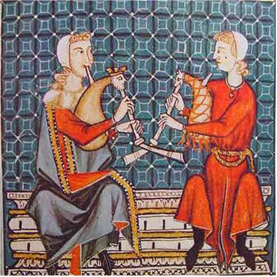

Here is a leading European early music ensemble's imagining of how it MAY HAVE sounded:
youtube
Here is another glimpse of the past, the painted ceiling of the Capella Palatina of Palermo, Sicily, Fatimid in style, from the 12th century. There are a lot of images of musicians on the six pages of this website.
In short, one mustn't take recordings of recreations of medieval music as gospel. Musicologists, music historians, and historical performers like myself do as best to be as authentic as we can, but the further we look back in history, the more we must engage in creative guesswork. It can be seen as artistic collaboration across time.
"The past is a foreign country."
- L.P. Hartley
13 notes
·
View notes
Text


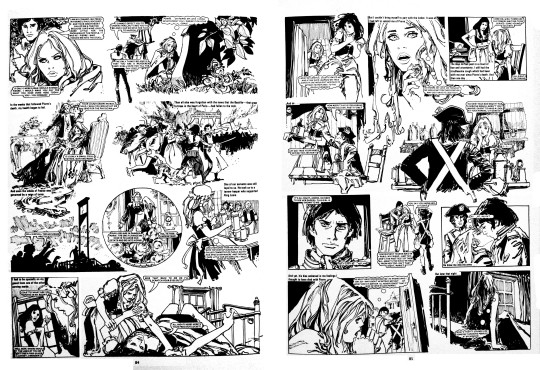


At @suburbanbeatnik /@trashpoppaea's request…
Shadow of the Guillotine
Outrageously clichéd French Revolution comic strip from the 1976 Jackie annual (publ 1975). I got it when I was 10. It might just pass muster as a Puccini opera plot, but it's completely OTT. Plus the characters look like 1960s-early '70s fashion models.
#french revolution#révolution française#historical fiction#popular historical iconography#comics#romance comic strip
20 notes
·
View notes
Text
The blacks, the greens and St. George
Mandatory: I am not an expert just an enthusiast and these are personal considerations based on knowledge of the history of art, you are invited to correct me if it seems to you that I have made mistakes.
@beneaththeshadows

At first I thought it was just a similar model, but given the lacing it seems obvious that they were inspired by it. Good catch!
Symbology of colors!
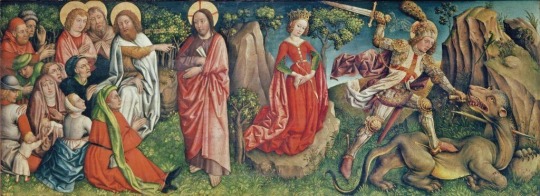
Let's start with the red that dresses the lady: this was considered the "noblest" color (as Dante defines it in the "Vita Nova") associated with purity, virtue and above all the passion of Christ.
It begins to take on, especially in northern European culture, a negative meaning linked to sin and opulence especially after the Lutheran Reformation due to the association with the papacy of Rome.
In the most widespread iconography of "St. George and the Dragon" the lady is dressed in red and red is also the cross of the Knight's shield.
The knight, on the other hand, wears black armor, the one that in chivalric novels is often associated with the positive hero who must prove his value, the protagonist.

Now it is interesting to note that in our story the girl in red and the black knight are none other than Rhaenyra and Daemon at the tournament. These are the Targaryen colors which in “Saint George and the Dragon” are instead placed in opposition to the dragon.
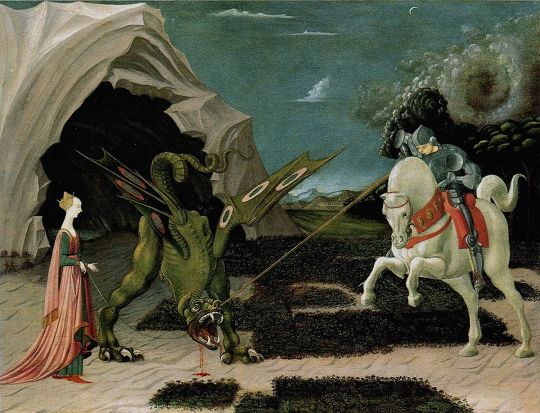
Let's talk now about green. This color that we often associate with nature did not enjoy great popularity in this historical period. The first reason is that it was difficult to obtain, it was an unstable pigment and the color became associated with perfidy and hypocrisy. When Shakespeare in "Othello" talks about a green-eyed monster the audience understands him.
It is worth noting how the legend of "St. George and the dragon" arrived in Europe around the twelfth century and became popular in the Crusader environment. Given the importance of the color green within Islam, it is not difficult to understand how this has only accentuated the negative connotation of color.
Green is the color of that which rots, of what is poisonous, of snakes, toads, crocodiles, green is the color of dragons!
Alicent in the series is visually associated with a religious imaginary (the seven-pointed star), and her adaptation shows her as a suffering madonna. This is how Criston sees her: an angelic woman, in stilnovist taste, who with her devotion crushes the dragon with her heel.
It's quite ironic in “House of the dragon” to see the dragon wearing red and black and instead the lady wears the infamous color.
Could this symbolize a reversal of roles ?! The beginning of the end of the dragons?
The most striking example of the reinterpretation of "Saint George and the Dragon" we have from Martin is the alleged kidnapping of Lyanna by Prince Rhaegar, with Robert as the dragon slayer.
What does all this mean? I don't know, maybe nothing, but it's an interesting parallel.
46 notes
·
View notes
Text
The Nath Yogis
From: Embodying the Formless: Spiritual Practice in the Nath Sampraday
Photography: Sriram Sabhapathy
Curation and Captions: Kartikay Khetarpa
Source: Sahapedia
The Nāth Sampradāya today comprises an order of renunciate ascetics and a householder caste, both of which trace their lineages to a group of nine Nāth gurus headed by Ādinātha (“First Nāth”), who is identified with the god Śiva. Next in most lists of nine Nāths comes Matsyendranātha, followed by Goraksanātha (Gorakhnāth), who is ̣ said to have founded the Nāth order of ascetics. he earliest references to the Nāth ascetic order as an organized entity date to the beginning of the 17th century, but its irst historical gurus,
Matsyendranātha and Goraksanātha, lived much earlier, probably in the 9th and 12th centuries, respectively, and during the intermediate period there are numerous references to both ascetic and householder Nāths in texts, inscriptions, iconography, and historical reports.
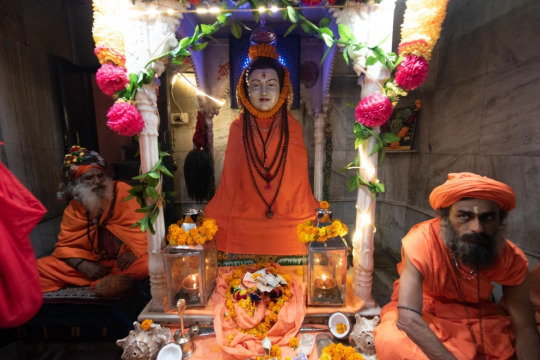
"An idol of Gorakhnath at the Jwalamukhi Shaktipeeth in Himachal Pradesh. Perhaps the most important figure in the tradition, Gorakhnath features in many popular Hindu legends. According to one such story, which is often connected to the origin of the sampraday, he is said to have ‘saved’ his guru Matsyendranath (who is believed to have been a direct disciple of Shiva) from the land of women where he gets entangled in worldly pursuits. Gorakhnath, his disciple, eventually rescues him and exhorts him to return to his original renunciant condition, setting up the Nath sampraday in the process."

"A Nath yogi at the Shri Gorakshnath Mandir (Barah Panth Dalicha) at Pushkar. Pushkar is an important center for the Naths with separate mathas for both the ascetic as well as the householder branch of the sampraday. A mela or festival is organized here every year on the Kartik Purnima (full moon of the Kartik month of the Hindu calendar) which is attended by hundreds of Nath ascetics travelling from all parts of the country."
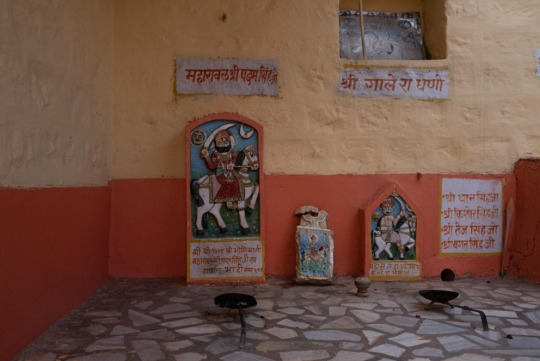
"Shrines to local folk deities at a Nath matha in Pokhran. Nath mathas can either be panchayati (communal) or niji (private). The panchayati mathas are centres for the ramta ascetics to congregate on festivals of importance and for elections of leaders. They are much fewer in number in comparison to the niji mathas which generally come up around the figure of charismatic Nath ascetics and have an independent mode of functioning. In Rajasthan, apart from gurus and deities associated with the Nath sampraday, such mathas also often house shrines dedicated to local heroes and folk deities."

A depiction of the Navnaths and the 84 siddhas at the Guru Gorakhnath-ji matha in Myajlar (Jaisalmer). The Navnaths are revered alongside the 84 siddhas (an archetype that in some sense symbolizes all individuals who are able to achieve spiritual perfection in their lifetime).
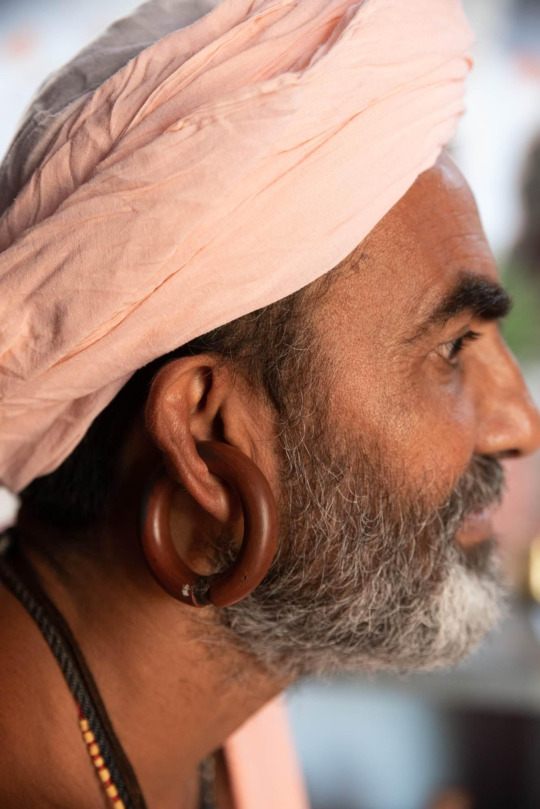
"A defining attribute of Nath ascetics are the large round earrings that many of them wear. Also known as the darshan mudra or kundal, these earrings are worn through the cartilage (not the lobe) and can be made of wood, horn, gold, silver or any other material preferred by the yogi. The ear-splitting ritual is performed only after a Nath initiate has spent considerable time as an apprentice. Comparable to a second birth, it is also treated as testimony to the initiate’s spiritual perfection.'

"A Nath yogi working on preparing the seli."
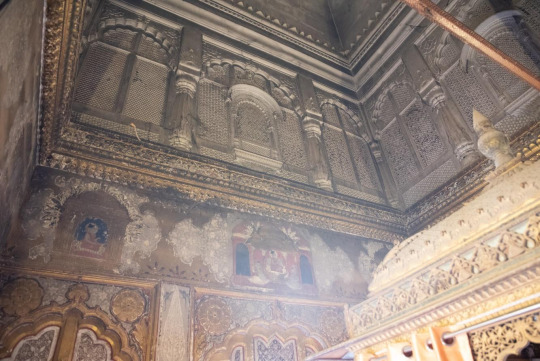
"The Naths in Rajasthan are said to have sustained a flourishing relationship with royalty who often bestowed land grants and other munificient giftson them in regard for their supernatural powers. The lavish interior of the Mahamandir is an indication of this."

"This is also the time when the ramta Nath ascetics travel to the temple. Hundreds of them gather at the Gorakh Dibbi which is a separate section of the temple governed by the Naths. A special religious ceremony is performed here at this time of the year."
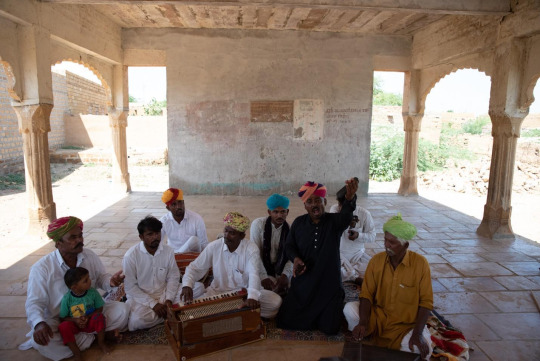
"A Manganiyar family in Kanoi (Jaisalmer) sings from their repertoire of Nath bhajans. Bhajans and kirtans are an important part of the devotional life of the Naths. In Rajasthan, while Nath bards themselves perform the epic tales of their ascetics, heroes and kings, on many occasions other communities, including the Muslim Manganiyars, are also invited to Nath gatherings and mathas to sing from their repertoires, which can relate either to the Nath sampraday specifically or to the larger nirgun bhakti tradition in the region."
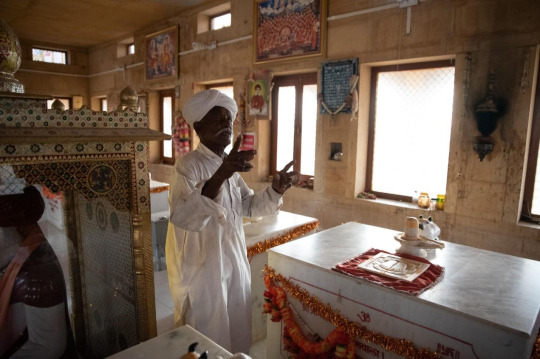
"Amolakhram ji, an elderly from the Meghwal community, recites bhajans associated with both the Sant and the Nath traditions. As he sings, he plays the tandoora (an instrument akin to the veena) with his right hand, and a jhinjha (wooden hand cymbals) with his left. The Sant and the Nath traditions draw from as well as compete with each other in the Rajasthani public sphere. While both tend to emphasize nirgun bhakti, one can often also come across songs that are written as dialogues of one-upmanship between a prominent Nath figure like Gorakhnath and a prominent Sant like Kabir. Where the loyalties of the singer or the patron lie is what generally determines the outcome of such a parley."
#Nath Sampraday#Rajasthan#Photography#Religion#Bhakti#Yogi#Gorakhnath#India#Sant#Nath#Shrine#Indic#Tradition#Asia#personal archive
3 notes
·
View notes
Note
Hello! I've read your post about the ten kings of hell dating from a couple years ago, and i was wondering if there were any sources you'd recommend on the topic? To tell the truth, I've been watching the Hozuki no Reitetsu anime lately, and having studied art history, it made me interested in the iconography of the kings of hell in Japan, ancient and modern, and especially if said iconography ended very codified, ie each king with features that made them recognizable (following on next ask)
(second part of previous ask) To give a specific example, There is a joke in Hozuki no Reitetsu about king Jotai having red clothes and a beard making him look like santa claus, and i'm really wondering whether 1) it is a complete invention from the author 2) popular modern iconography tend to represent him that way 3) one or more ancient sources paint him that way, but it's obscure-ish knowledge and it is not part of the common cultural references most modern japanese people have
(end of previous asks) Anyway, thank you for your post that was very interesting! I also hope i managed to convey my points clearly enough to be comprehensible (also I meant king Sotei, the third king of the underworld, and not king Jotei as I think i mistakenly said)
Oh hey, I did watch the same anime at some point, I think there might even be some remnants of a liveblog... somewhere. I think the manga's style was more charming from what little I've seen of it tbh. Enma and Miki were the best characters from what I remember.
Anyway, onto the actual question. I do not think there is anything like distinct iconography of any of the kings other than Enma, Taizan and Godo - doesn't help their origins are pretty nebulous, too. All three of these who do have pretty distinct appearance were already worshiped before the notion of ten kings even arose - Yama/Yanluo/Enma is self-explanatory, Taishan/Taizan is obviously the divine representation of mount Tai, and Wudao/Godo was initially a figure in "apocryphal" Chinese accounts of the historical Buddha's life whose precise origin is uncertain. Taizan is unique in that he is the source of the original variant of the judge uniform all ten are usually depicted wearing, Enma in Japan developed the unique red or otherwise outlandish appearance but I have no clue how since Chinese Yanluo doesn't seem to be portrayed differently from other kings. I am actually not sure if the unique iconography of Godo ever reached Japan, though - all the depictions where he looks distinct I've seen. like this one, are of Chinese Wudao... He's dressed like a military commander rather than a judge, which does reflect his role in these texts about the Buddha. I am not sure if we can really talk about codification, either, but this is a topic I am still researching rn, I will get back to this soon-ish since I have something related to this matter planned.
As for Sotei's portrayal in the aforementioned anime: I do not think it's a pun on the name. Sotei(-o) goes back to earlier Chinese Songdi (Wang), a pretty straightforward name, "Emperor of Song"; I do not see much of a connection between Santa and this. I do not think 宋帝(王) looks anything like サンタ(クロース) so I doubt it's some sort of visual joke of this sort, though do not quote on this. The most famous painting of Sotei is without a doubt this one, where he actually is depicted in a red robe. Not sure about the beard. I would say that given the painting's modern esteem it's fair to say it's as close to a "canonical" iconography as you can get...? The only other modern media portrayal of him I am aware of isn't really similar though (it's from the weird 2007 Gegege no Kitaro adaptation). And note that there are other depictions of Sotei (or his Chinese forerunner) in all sorts of robes. I think one of the papers I linked in my original post shows him in white robes, actually. I am really not sure what the joke here might be, I think the gimmicks assigned to some of the kings in Hoozuki no Reitetsu were entirely the idea of the author tbh, especially since most of them were one note joke characters.
I am going to look into whether there's anything newer on the Ten Kings than what the bibliography of the old post has to offer, I will update the post if something unexpected shows up.
9 notes
·
View notes
Note
An example of Blackwashing is a post on Tumblr with black models portraying the Greek gods.
To me as a Greek is culturally inappropriate and offensive. Also it has become tiresome that our culture has turn into an "aesthetic"/OC for foreigners without caring about course material and historical accuracy.
And the fact that this post has over 100k notes does not help that has such a popularity. I am saying it in a way that this much attention to the foreigner viewer just keeps promote the false accuracies we talk for soo long.
They say in the comments that it's cool but if people started doing the opposite they would be furious. So why portraying the Greek gods in every other culture is considered okay? 🤔
Bc this is Tumblr, I think you should clarify a bit more that it is offensive not because you don't like seeing Black people interacting with Greek culture but because that post encourages USians to see the culture and religion as a costume and as their property.
I didn't see any similar photoshoots of Black (as in African American) people as Japanese or Indian gods, and Black rappers who included Indian and Hindu iconography in their promotions as an aesthetic got backlash for cultural appropriation. So while I have more important things in my day than to tackle that particular post, yeaaah I can see how it would strengthen that entitlement.
8 notes
·
View notes